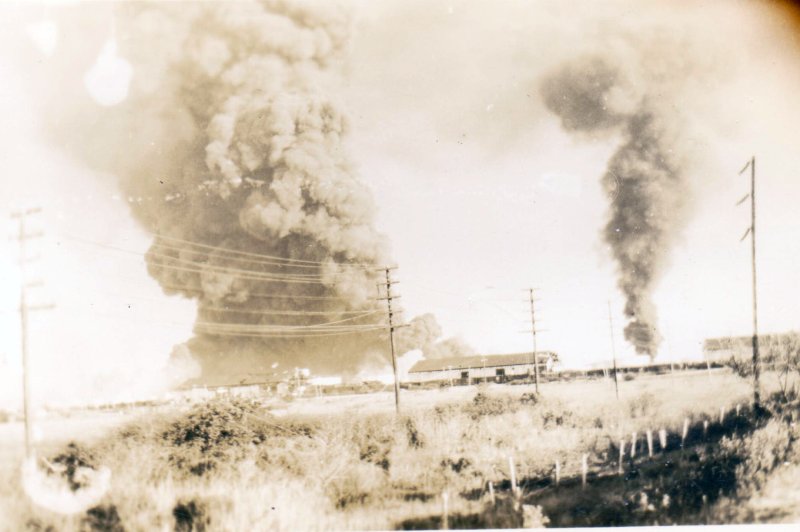Smoke is seen from a distance from the Texas City, Texas, blast on April 16, 1947, that left nearly 600 people dead. File Photo by
Judge Alfred S. Gerson/Wikimedia
TEXAS CITY, Tex. -- Firemen Thursday afternoon were bringing under control the last blazes of a 24-hour chain of explosions and flame which ravaged this Texas Gulf Coast industrial town and left perhaps 700 persons dead.
At 2 p.m. (EST) only three pillars of black, oily smoke rose from the two-mile long waterfront area hardest hit by the holocaust which began at 9 a.m. Wednesday with explosion of a nitrate-loaded French freighter at a dock. Firemen equipped with chemicals were moving in on the last blazes.
Earlier Thursday, the town rocked to new blasts, one of which disintegrated another freighter and sowed new death and injury among survivors and rescue workers.
Governor Estimates
Gov. Beauford Jester issued from Austin an official estimate, based on Red Cross figures, that 600 to 650 persons had been killed and 3,000 injured. In Washington the Red Cross said 400 were known dead, possibly 250 to 375 additional dead, and more than 3,000 injured, in one of the grimmest tragedies of American disaster history.
Jester's estimates were broken down as follows: embalmed dead, 364; positive dead, 400; estimated dead, an additional 200 to 250. Hospitalized injured, 350 to 400, many in serious condition; estimated total injured, 3,000.
But no casualty figure could be much better than a guess. More than 400 bodies had been counted. Not until the flames subside could the thousands of rescue workers hope to reach other bodies -- perhaps scores, perhaps hundreds -- in the waterfront ruins.
The vast Monsanto Chemical Co. plant, left a "ruined shell," may hold the fate of many persons, officials said. About 8000 were working there Wednesday morning when the French freighter Grandcamp blew up, throwing chunks of steel for miles and setting off the chain of blasts and fire.
The $10,000,000 plant, which combines highly inflammable propane an benzol, to make styrene for synthetic rubber, was destroyed in the fire which followed the blast aboard the freighter. The building was adjacent to the freighter's dock.
Second Ship Explodes
The fate of crewmen aboard the French lines ship and the American freighter High Flyer, which was torn to bits by an explosion Thursday -- 16 hours after the Grandcamp explosion -- was unknown. First word that any board the French Lines Office in New York, which said that at least five were alive, two of them critically injured.
J.C. Trahan, mayor of this town which Wednesday had 18,000 inhabitants of whom half already had fled, said he believed all danger of further major explosions had been passed.
A north wind blew the smoke and noxious fumes out over Galveston Bay, and helped to keep the flames from spreading inland. Of it, Deputy Mayor J.H. Hill said:
"The Lord is on our side."
Damage estimates ranged from $50,000,000 to $125,000,000 and the latter figure seemed to observers in the blasted area more likely.















